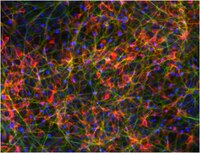Learning induces neurotrophin signaling at hippocampal synapses.
Lulu Y Chen,Christopher S Rex,Yas Sanaiha,Gary Lynch,Christine M Gall
Proceedings of the National Academy of Sciences of the United States of America
107
2010
Show Abstract
Learning-induced trophic activity is thought to be critical for maintaining health of the aging brain. We report here that learning, acting through an unexpected pathway, activates synaptic receptors for one of the brain's primary trophic factors. Unsupervised learning, but not exploratory activity alone, robustly increased the number of postsynaptic densities associated with activated (phosphorylated) forms of BDNF's TrkB receptor in adult rat hippocampus; these increases were blocked by an NMDA receptor antagonist. Similarly, stimulation of hippocampal slices at the learning-related theta frequency increased synaptic TrkB phosphorylation in an NMDA receptor-dependent fashion. Theta burst stimulation, which was more effective in this regard than other stimulation patterns, preferentially engaged NMDA receptors that, in turn, activated Src kinases. Blocking the latter, or scavenging extracellular TrkB ligands, prevented theta-induced TrkB phosphorylation. Thus, synaptic TrkB activation was dependent upon both ligand presentation and postsynaptic signaling cascades. These results show that afferent activity patterns and cellular events involved in memory encoding initiate BDNF signaling through synaptic TrkB, thereby ensuring that learning will trigger neurotrophic support. Full Text Article | 20356829
 |
Nicotinic alpha 7 receptor clusters on hippocampal GABAergic neurons: regulation by synaptic activity and neurotrophins.
Kawai, Hideki, et al.
J. Neurosci., 22: 7903-12 (2002)
2002
Show Abstract
Nicotinic acetylcholine receptors containing the alpha7 gene product are expressed at substantial levels in the hippocampus. Because of their specific locations and their high relative calcium permeability, the receptors not only mediate cholinergic transmission in the hippocampus but also influence signaling at noncholinergic synapses. We have used fluorescently labeled alpha-bungarotoxin to image alpha7-containing receptors on hippocampal neurons and to examine their regulation in culture. The highest levels of staining for such receptors were most commonly found on GABAergic interneurons identified immunohistochemically. The receptors were distributed in clusters on the soma and dendrites and were localized in part at GABAergic synapses. A 3 d blockade of electrical activity with tetrodotoxin or NMDA receptors with APV dramatically reduced the proportion of GABAergic neurons expressing high levels of receptor staining and reduced the mean number of distinguishable receptor clusters on individual neurons. Blockade of either GABA(A) receptors with bicuculline or nicotinic receptors with d-tubocurarine had no effect, although exposure to nicotine could increase the level of receptor staining. Anti-BDNF and anti-NGF antibodies produced decrements equivalent to those of tetrodotoxin and APV, whereas addition of BDNF and NGF each increased staining levels and increased the number of distinguishable receptor clusters on GABAergic neurons. The exogenous neurotrophins could not, however, overcome the effects of either tetrodotoxin or APV. The results indicate that both NMDA receptor activation and the neurotrophins BDNF and NGF are necessary to sustain the distribution patterns of alpha7-containing nicotinic receptors on GABAergic hippocampal neurons. | 12223543
 |










